|
|
Information
Service of
the Serbian Orthodox Church
Oktober 4, 2004

MEMORIAL
SERVICE FOR VICTIMS OF NAZI TERROR
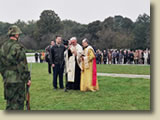 In
the period from 1941 to 1944 a concentration camp for Serbs, Roma
and Jews was created by the Nazi occupying forces in the village
of Jajinci near Belgrade, the location of the former military
proving ground of the Kingdom of Yugoslavia. One hundred and twenty
seven thousand men, women and children perished in this hellhole.
The camp was liberated on October 2, 1944 and the Jajinci Memorial
Complex was opened in 1964. In
the period from 1941 to 1944 a concentration camp for Serbs, Roma
and Jews was created by the Nazi occupying forces in the village
of Jajinci near Belgrade, the location of the former military
proving ground of the Kingdom of Yugoslavia. One hundred and twenty
seven thousand men, women and children perished in this hellhole.
The camp was liberated on October 2, 1944 and the Jajinci Memorial
Complex was opened in 1964.
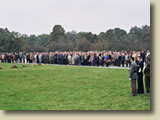 Sixty
years later, on Saturday, October 2, 2004, the surviving concentration
camp prisoners, members of their families and friends gathered
at the execution site of the former Jajinci concentration camp.
Protopresbyter-Stavrophor Professor Sixty
years later, on Saturday, October 2, 2004, the surviving concentration
camp prisoners, members of their families and friends gathered
at the execution site of the former Jajinci concentration camp.
Protopresbyter-Stavrophor Professor 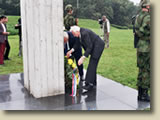 Dr.
Dimitrije Kalezic and Protodeacon Professor Radomir Rakic served
a short memorial service. In his sermon Father Dimitrije emphasized
the importance of their suffering and martyrsí deaths. Also addressing
those present was the director of the Office for Morale of the
Serbia and Montenegro Army General Staff, Major-General Vidosav
Kovacevic, who talked about the price of freedom and the patriotism
of those Dr.
Dimitrije Kalezic and Protodeacon Professor Radomir Rakic served
a short memorial service. In his sermon Father Dimitrije emphasized
the importance of their suffering and martyrsí deaths. Also addressing
those present was the director of the Office for Morale of the
Serbia and Montenegro Army General Staff, Major-General Vidosav
Kovacevic, who talked about the price of freedom and the patriotism
of those 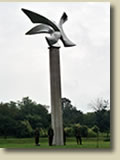 who
perished at the execution site. Ms. Radmila Hrustanovic reminded
those present that 127,000 patriots were killed on this location
and that the primary reason for their persecution was that they
were Serbs, Jews and Roma. who
perished at the execution site. Ms. Radmila Hrustanovic reminded
those present that 127,000 patriots were killed on this location
and that the primary reason for their persecution was that they
were Serbs, Jews and Roma.
Representatives
of the Serbia and Montenegro Army, Belgrade municipalities and
other institutions laid wreaths at the memorial marker.
The
memory of those who perished in this Belgrade concentration camp
was honored with gun salutes and a minute of silence.

SERBS
FROM METROPOLITANATE OF ZAGREB AND LJUBLJANA
VISIT BELGRADE PATRIARCHATE
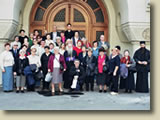 A
group of about 30 people visited the Patriarchate and the Serbian
Orthodox Church Museum on Friday, October 1, 2004 at the invitation
of His Eminence Metropolitan Jovan of Zagreb, Ljubljana and all
Italy. Director Slobodan Mileusnic welcomed the guests to the
Museum and acquainted them with its cultural heritage, showing
them Sister Jefimijaís Praise to Prince Lazarus, the cape of Prince
Lazarus, the tapestry of King Milutin, the charter of the Empress
Maria Theresa and many other items. A
group of about 30 people visited the Patriarchate and the Serbian
Orthodox Church Museum on Friday, October 1, 2004 at the invitation
of His Eminence Metropolitan Jovan of Zagreb, Ljubljana and all
Italy. Director Slobodan Mileusnic welcomed the guests to the
Museum and acquainted them with its cultural heritage, showing
them Sister Jefimijaís Praise to Prince Lazarus, the cape of Prince
Lazarus, the tapestry of King Milutin, the charter of the Empress
Maria Theresa and many other items.  During
their visit to the Patriarchate chapel of St. Simeon the Myrrh-gusher
Metropolitan Jovan also showed the guests the meeting room of
the Holy Assembly of Bishops and the painting Seoba Srbalja (The
Migration of the Serbs), the work of the famous Serbian painter
Paja Jovanovic, which decorates it. During
their visit to the Patriarchate chapel of St. Simeon the Myrrh-gusher
Metropolitan Jovan also showed the guests the meeting room of
the Holy Assembly of Bishops and the painting Seoba Srbalja (The
Migration of the Serbs), the work of the famous Serbian painter
Paja Jovanovic, which decorates it.
Metropolitan
Jovanís guests also toured some of the greatest of Serbian holy
shrines: the monasteries of Studenica, Zica, the Pillars of St.
George in Ras, Sopocani, Veluce and Ljubostinja.

BELLS
OF CHURCH DEDICATED TO ST. MAXIM
THE CONFESSOR CONSECRATED
 The
church of St. Maxim of Confessor is located in Novi Kostolac,
a mining village on the Danube located 12 kilometers from Pozarevac
in the Diocese of Branicevo. Since itís founding in the 1940s
this village has never had a Church and hence it has been a mission
parish in the Diocese of Branicevo. Building of the church of
St. Maxim the Confessor began in the summer of 1999 and all that
remains is the completion of the interior. This is the first church
in Serbia to be dedicated to St. Maxim the Confessor. The
church of St. Maxim of Confessor is located in Novi Kostolac,
a mining village on the Danube located 12 kilometers from Pozarevac
in the Diocese of Branicevo. Since itís founding in the 1940s
this village has never had a Church and hence it has been a mission
parish in the Diocese of Branicevo. Building of the church of
St. Maxim the Confessor began in the summer of 1999 and all that
remains is the completion of the interior. This is the first church
in Serbia to be dedicated to St. Maxim the Confessor.
Kostolac is
a unique place with some fifteen nations from all regions of the
former Socialist Federal Republic of Yugoslavia Ė the former Yugoslavia
on a small scale, so to speak. Here, in this very place, the church
of St. Maxim sprang up, a Saint of the East and the West. He lived
in Constantinople in the 7th century A.D. and was banished to
the West. He found sanctuary in Rome and was acknowledged by the
Western brothers, unlike the Easterners of the time who had banished
him. After several trials by the Byzantines, he was banished,
after his hand and tongue were amputated, to the Caucasus, where
he died in 662. Today a small church dedicated to St. Maxim the
Confessor exists over his grave in Georgia.
The parish of St. Maxim is just beginning to live its liturgical
life. In it everything is a first: the first liturgy, the first
group baptism in the Danube, the first religious procession through
the streets on the occasion of the celebration of the newly chosen
village patrol saintís day of St. Prokopios (July 21), etc. The
parish priest, who is the author of this text, together with his
flock, shares close ties with his spiritual father, Bishop Ignjatije
of Branicevo, who has on numerous occasions visited the church,
provided advice and conducted no less than three consecrations
(the site, the crosses and the bells). This year Bishop Ignjatije
began the celebration of his tenth year in office in the church
of St. Maxim with the consecration of the bells and phiala on
September 24 in the presence of our dear and respected guest from
Athens, Metropolitan Joannis (Zizioulas) of Pergamum, and many
people. Of course, the first Holy Hierarchal Liturgy will be served
on the day of the consecration of the Church itself.
During the
course of the following year Father Stamatis Skliris, a painter
from Athens, will begin painting the frescoes, which will add
to the churchís uniqueness and originality. Even though it is
still under construction, the churchyard is already decorated
with manicured lawns, many young fruit trees and the newly consecrated
phiala with a fountain above which is a fresco of the Mother of
God with Christ called the Life-Bearing Source. The phiala is
a place where baptisms will be held in summer and water will be
consecrated on the Theophany in winter.
It is important
to emphasize the selfless participation of the faithful not only
at liturgy but also during the construction work, where everyone
took part according to his abilities thus leaving a permanent
mark on this church. Of course, nothing is finished yet, original
efforts are still before us, and the building of this church is
an open field for new creativity. Finally, in accordance to the
wise teaching of St. Maxim, the real Truth regarding the world
and humans will be revealed, and accordingly the church of St.
Maxim the Confessor will shine in its full glory.
Father
Aleksandar Mihailovic
Pozarevac

[Serbian
Translation Services]
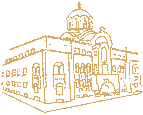
Copyright © 1999-2004 by
The Information Service of
the Serbian Orthodox Church
11000 Belgrade
Kralja Petra I no.5
+381 11 3282 596
e-mail
|

